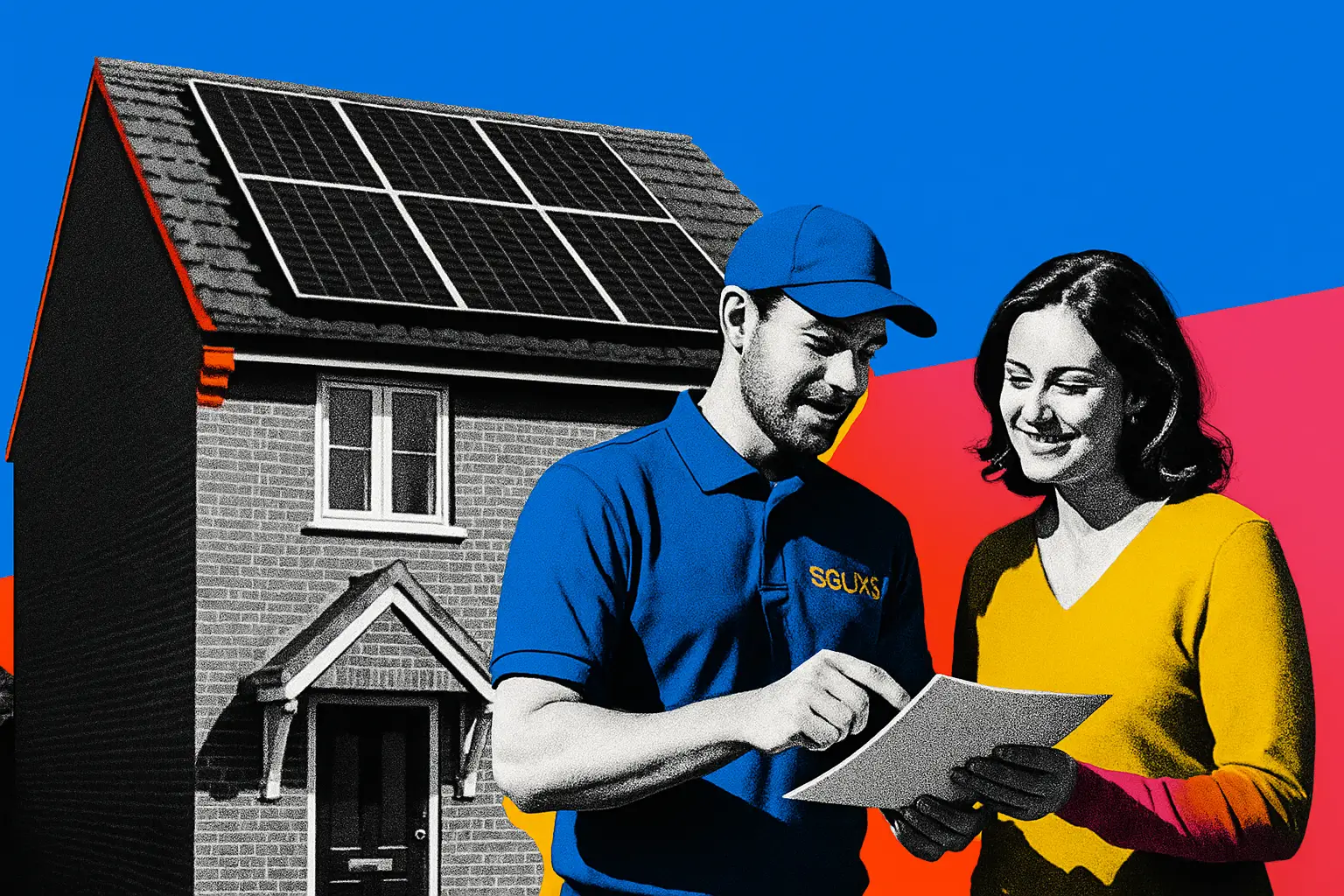How to get approved for Solar panels Home services (UK)
A no-faff UK guide to solar approvals, DNO rules, MCS installers, SEG payments, and planning checks so you get connected, compliant, and paid for your exports without delays.
Your quick route to a green light
Look, you want solar on the roof without the runaround. This guide shows you exactly how to get approved, connect to the grid, and start earning from your surplus electricity.
The faster you sort permissions and paperwork, the sooner you start saving.
Is this you?
If you live in Great Britain and want a straightforward path to a compliant, grid-connected solar system, this is for you. Ideal for homeowners planning 3 kWp to 6 kWp arrays, battery-curious buyers, and anyone who wants Smart Export Guarantee payments without tripping over rules.
Jargon, decoded for normal humans
- DNO - Your local Distribution Network Operator. They control grid connection approvals.
- 3.68 kWp rule - Above this size, you normally need DNO permission before install. Apply early.
- G98, G99, SGI - UK grid connection standards. G98 suits very small systems. Most home PV uses G99 or the Small Generation Installations route for quicker handling.
- MCS - Microgeneration Certification Scheme. Using an MCS installer protects quality and unlocks SEG payments.
- SEG - Smart Export Guarantee. Your supplier pays you for the clean electricity you export to the grid.
- Building regs - UK safety and structural rules. Competent installers self-certify and issue a Building Regulations Completion Certificate.
- Permitted Development - Most roof solar does not need planning permission, except in special cases like listed buildings or some conservation areas.
- Inverter and battery - The inverter converts DC to AC. A compatible battery lets you store surplus for evening use.
Your main choices, simply laid out
- System size and design
- Under or near 3.68 kWp could allow simpler approvals, but many homes go 4 kWp to 6 kWp for better savings. Bigger systems almost always need G99 approval.
- Installer selection
- Pick an MCS-certified installer. It is essential for SEG and proves the job meets UK standards. DIY may be legal but risks safety, insurance, and incentive eligibility.
- With or without battery storage
- Battery adds cost but boosts self-consumption and resilience. Good for those home in evenings or facing peak-rate tariffs.
- Planning and location
- Most pitched-roof installs are fine under Permitted Development. Exceptions apply for listed buildings, conservation areas, and some flat roofs with height limits. Always check locally.
- Timeline expectations
- On-roof work usually takes 2-3 days. The long pole is DNO approval, which can take 4-11 weeks depending on route and DNO workload.
Connection application routes at a glance
| Route | Typical system size | Who applies | Typical approval | Possible fees |
|---|---|---|---|---|
| G98 | Very small microgeneration | Installer | Faster notification route | Low or none |
| G99 - SGI | Common for domestic PV | Installer | Around 4-8 weeks | Varies by DNO |
| Full G99 | Larger or complex systems | Installer | Up to 11 weeks | Varies by DNO |
Money, timing, and practical impact
- Install time on-site: usually 2-3 days including mounting, wiring, and inverter setup.
- Overall project time: often 4-11 weeks due to DNO approvals and any planning checks.
- Cost drivers: system size, roof complexity, scaffolding, inverter type, and battery option. Budget for installation, certification, and potential grid connection fees.
- Returns: SEG payments for exported electricity plus bill savings from self-consumption. Batteries can improve savings if you use more power after dark.
- Risks of skipping steps: installation delays, rejection by the DNO, safety issues, loss of SEG eligibility, and problems when selling your home due to missing building regs paperwork.
Standout line: MCS installer plus timely DNO approval equals smooth install and paid exports.
Who can get it and what you need
- Homeowners across Great Britain can install solar, with most roof installs allowed under Permitted Development. Check if your home is listed or in a conservation area.
- Over 3.68 kWp? Expect a G99 application to the DNO before installation. Smaller setups may use quicker routes, but your installer will advise.
- You will need MCS certification of the system and DNO confirmation to sign up for the Smart Export Guarantee.
- Building Regulations apply to all installs. Your installer should self-certify and issue a Building Regulations Completion Certificate - keep it safe for insurance and future sale.
- For flats or unusual roofs, extra planning rules and height limits may apply. Always confirm with your local authority or use an installer who handles permissions.
The straightforward plan - step by step
- Book a site survey and roof assessment.
- Confirm system size, panels, inverter, and battery.
- Installer prepares and submits the DNO application.
- Wait for G99 or SGI approval before install.
- Install panels, wiring, inverter, and battery.
- Safety checks and commissioning are completed.
- Installer notifies certification schemes and the DNO.
- Register for SEG with your energy supplier.
Upsides, trade-offs, and what to weigh
- Pros
- Lower bills and SEG export payments
- Clean energy with minimal maintenance
- Battery boosts independence and evening savings
- Adds appeal for buyers when paperwork is in order
- Cons
- DNO approvals can take weeks
- Upfront cost increases with batteries
- Planning exceptions for listed or conservation properties
- Roof shading or weak structure can limit output
Read this before you sign anything
- Apply to the DNO early if you are over 3.68 kWp. Delays here hold everything up.
- Insist on MCS certification and get all documents: MCS certificate, Building Regulations certificate, warranties, and commissioning report.
- Clarify whether your quote includes DNO fees, scaffolding, upgrades, and remedial works.
- Confirm inverter and battery compatibility, warranty length, and monitoring app access.
- Ask for realistic output and payback estimates, not best-case sunshine.
If solar is not a fit today
- Improve efficiency first - LED lighting, insulation, draught-proofing.
- Consider smaller starter systems or plan for a phased battery later.
- Look at green tariffs, smart meters, and time-of-use plans to maximise savings now.
- For new builds, note that rooftop solar is set to become standard under upcoming rules in England.
FAQs
-
Do I need planning permission? Most pitched-roof installs fall under Permitted Development. You may need permission for listed buildings, conservation areas, or some flat roofs. Check with your council.
-
When do I need DNO approval? If your system is above 3.68 kWp, expect a G99 application and allow 4-11 weeks. Your installer handles this.
-
Can I get paid for exports? Yes. With MCS certification and DNO confirmation, you can register for the Smart Export Guarantee with an eligible supplier.
-
How long does installation take? On-site work is typically 2-3 days, depending on roof complexity and weather.
-
Should I add a battery? A battery costs more but increases self-consumption and resilience. Great if you use most power in the evening.
-
Is DIY allowed? It is legal, but you risk safety issues, insurance problems, and losing access to SEG. Use an MCS-certified installer.
Ready to crack on?
- Get quotes from MCS-certified installers who include DNO applications and building regs self-certification.
- Ask for firm timelines, clear warranties, and monitoring details.
- Line up your SEG supplier so payments start once the system is commissioned.
Need a hand comparing quotes? Save time by asking installers to show DNO timelines and SEG eligibility up front.
Small print you should actually read
This guide is general information for Great Britain. Always verify local planning rules and your DNO requirements, as timescales and fees vary. Choose qualified, MCS-certified professionals and retain all certificates for insurance and future property sales.
Get smarter with your money
Join thousands of people in the UK who are taking control of their financial future

FAQs
Common questions about managing your personal finances
Begin by tracking every expense for one month. Use an app or spreadsheet. No judgment. Just observe your spending patterns.
Cancel unused subscriptions. Cook at home. Compare utility providers. Small changes add up quickly.
Aim for 20% of your income. Start smaller if needed. Consistency matters more than the amount.
Choose reputable apps with strong security. Read reviews. Check privacy policies. Protect your financial data.
Pay bills on time. Keep credit card balances low. Check your credit report annually. Be patient.
Still have questions?
Our team is ready to help you navigate your financial journey
More financial insights
Explore our latest articles on personal finance and money management




